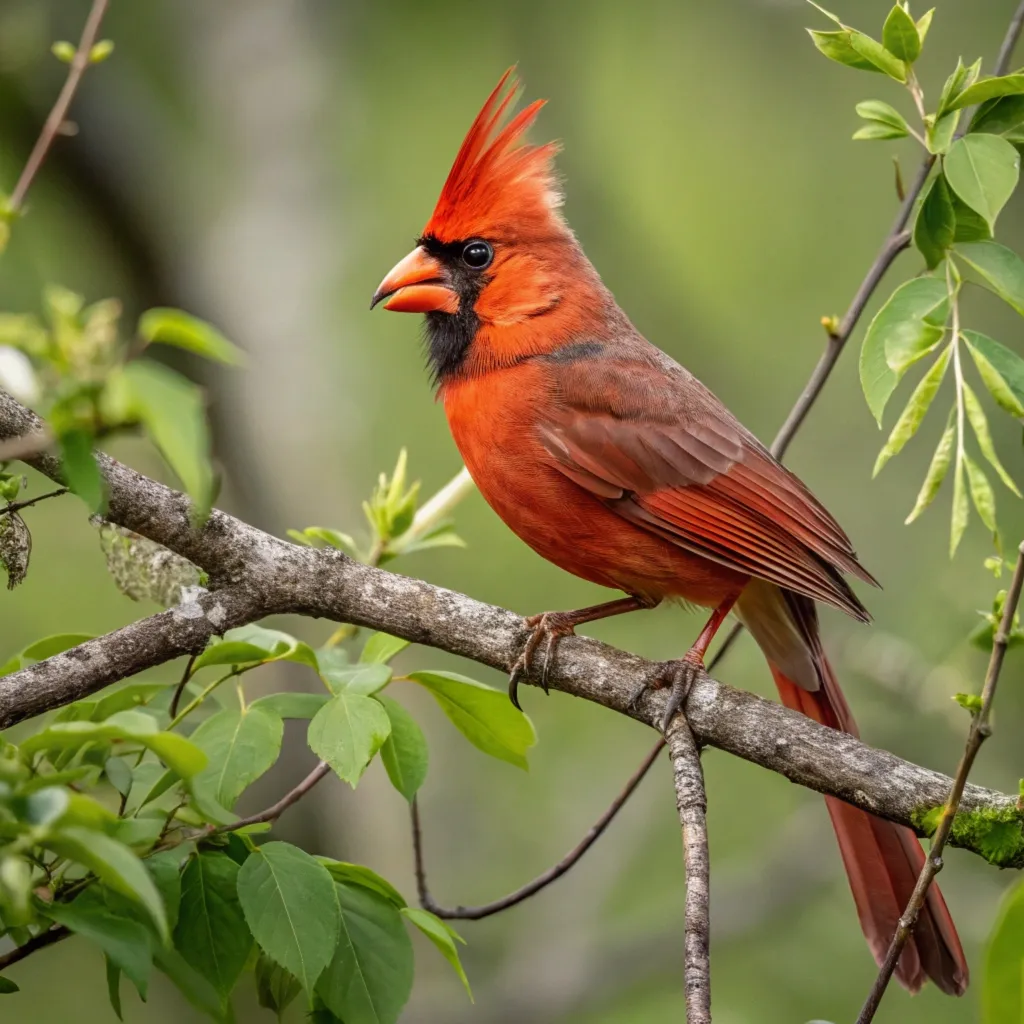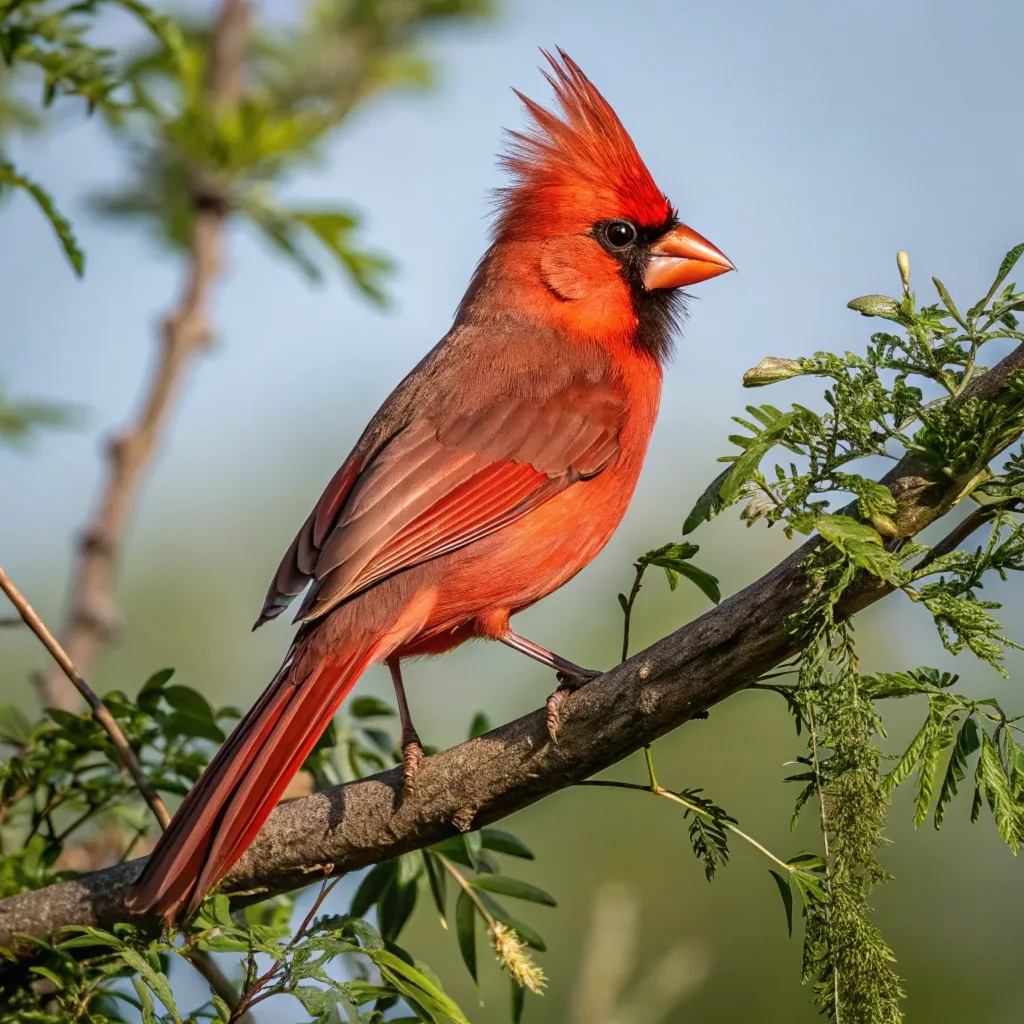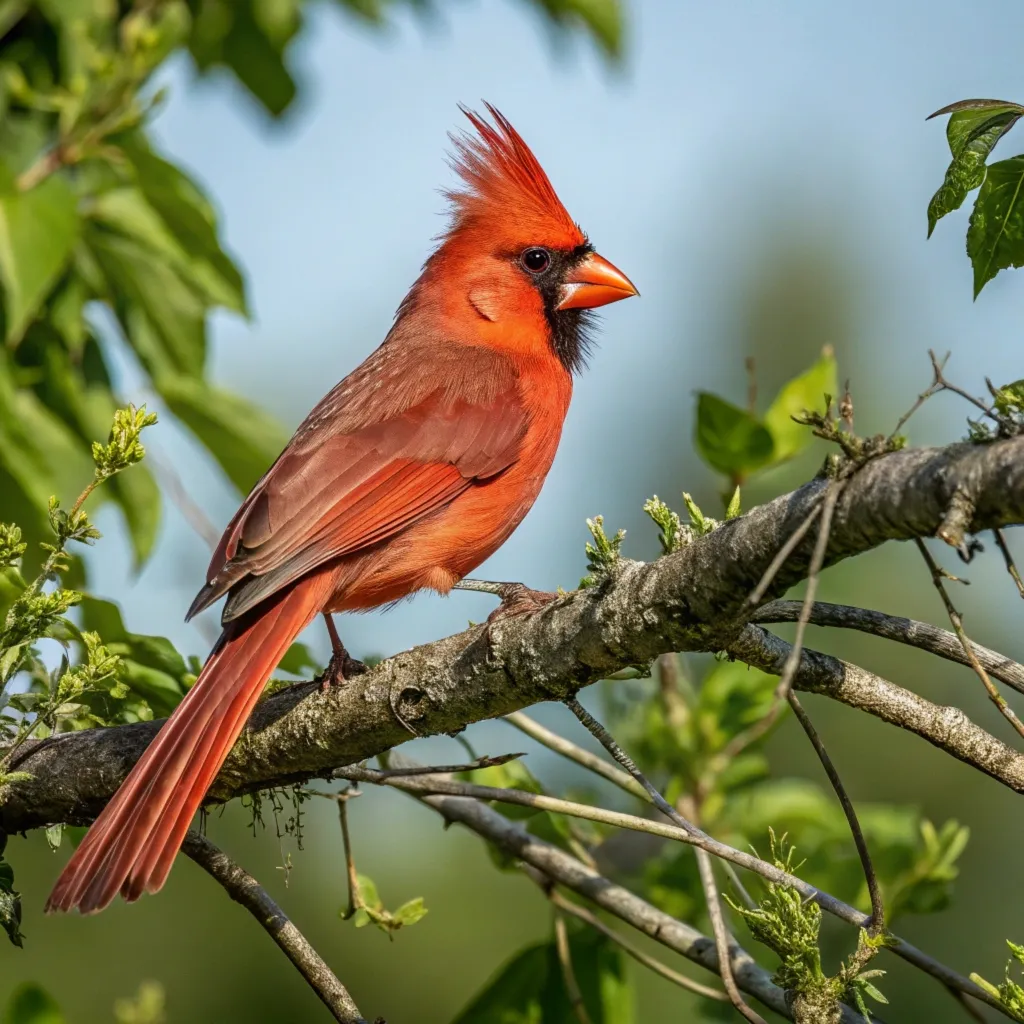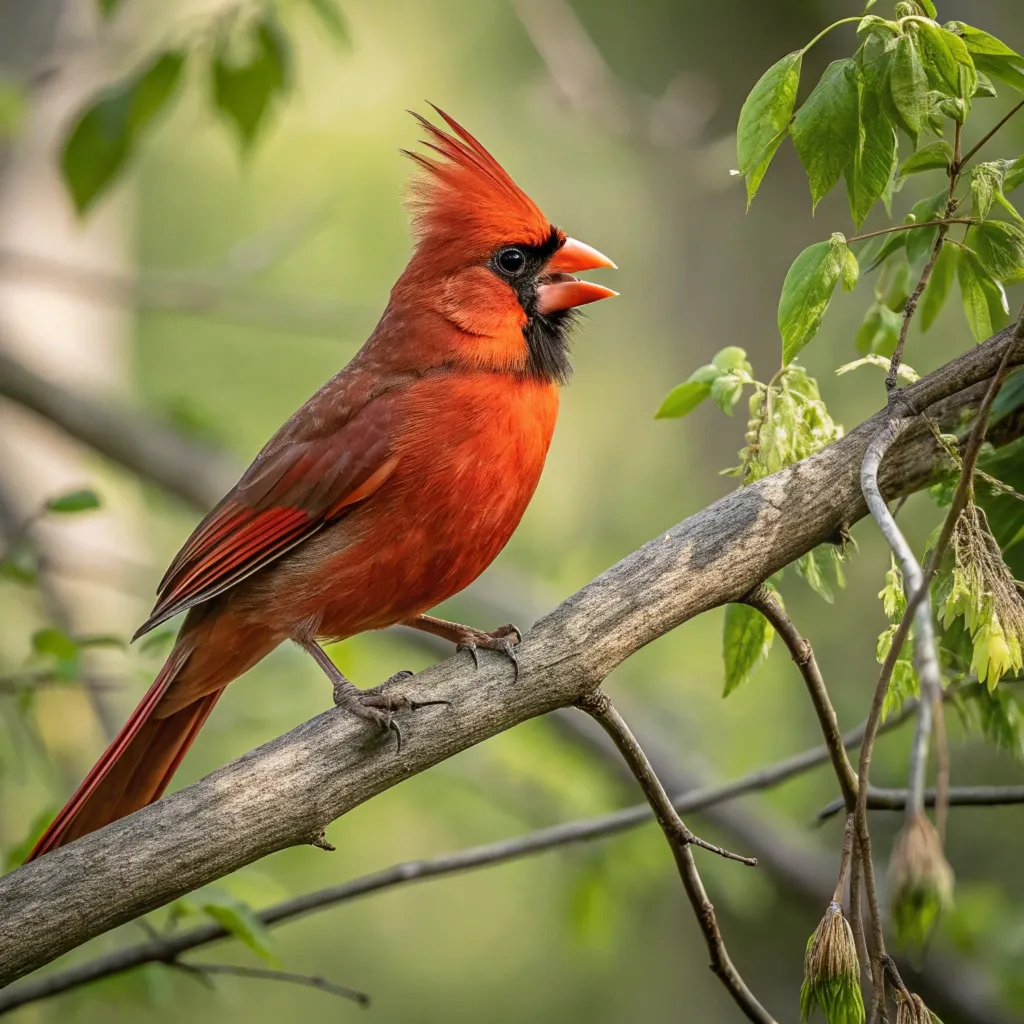Northern Cardinal: The Secrets of America’s Beloved Red Bird
The Northern Cardinal, with its vibrant red plumage and melodious song, stands as an iconic bird in North America.
This guide explores the key traits of this beloved species.
We delve into the cardinal’s physical features, behaviors, and habitat preferences.
Readers will discover fascinating facts about the cardinal’s diet, breeding habits, and ecological role.

Key Takeaways: Northern Cardinal Essentials
- Distinctive Appearance: Male cardinals boast bright red plumage, while females display reddish-olive coloration.
- Habitat Versatility: Cardinals thrive in various environments, from woodlands to urban gardens.
- Year-Round Residents: These birds do not migrate, remaining in their territories throughout the year.
- Seed Specialists: Cardinals possess strong, conical beaks adapted for cracking open seeds.
- Monogamous Breeders: They form strong pair bonds, often staying together for multiple breeding seasons.
- Territorial Behavior: Males fiercely defend their territories, especially during breeding season.
- Vocal Communicators: Both males and females are known for their distinct and melodious songs.
- Backyard Favorites: Cardinals frequently visit bird feeders, making them popular among bird enthusiasts.
- Protected Status: The species is safeguarded by the Migratory Bird Treaty Act in the United States.
- Cultural Significance: Cardinals serve as the official state bird for seven U.S. states.
Physical Characteristics of the Northern Cardinal
The Northern Cardinal stands out with its distinctive features. Males sport a vibrant red plumage that catches the eye, while females exhibit a more subdued reddish-olive coloration.
Both sexes possess a prominent crest on their heads, adding to their regal appearance.
Cardinals measure between 21-23 cm in length, with a wingspan ranging from 25-31 cm. Their bodies are designed for perching, featuring a long tail and short, thick bill perfect for cracking open seeds.
The plumage of Northern Cardinals serves multiple purposes beyond mere aesthetics. The bright red coloration of males acts as a visual signal to potential mates, indicating health and genetic fitness.
Conversely, the more muted tones of females provide excellent camouflage when nesting, helping to protect their young from predators.
Cardinals also possess strong legs and feet, which enable them to grip branches securely and forage effectively on the ground.
Their keen eyesight allows them to spot potential food sources and detect approaching threats quickly.
Habitat and Distribution

Northern Cardinals demonstrate remarkable adaptability in their choice of habitats. They thrive in:
- Edges of woods
- Swamps
- Riverside thickets
- City gardens
- Residential areas
Their range extends across eastern North America, from southern Canada to parts of Mexico and Central America. Cardinals have also been successfully introduced to Bermuda and Hawaii.
The versatility of Northern Cardinals in habitat selection has contributed significantly to their success as a species.
They show a particular affinity for edge habitats, areas where different ecosystems meet, such as the border between forests and fields. These zones often provide an ideal mix of food sources and nesting sites.
In recent decades, Cardinals have expanded their range northward, possibly due to climate change and increased availability of backyard feeders.
This expansion demonstrates their ability to adapt to changing environmental conditions.
Dietary Habits and Feeding Behavior
Cardinals are primarily granivorous, with seeds forming a significant part of their diet. Their strong, conical bills are specially adapted for cracking open seeds. Their diet includes:
- Weed seeds
- Sunflower seeds
- Grains
- Fruits (including berries)
- Insects (especially during breeding season)
This dietary flexibility allows cardinals to remain in the same area year-round, adapting their food choices based on seasonal availability.
The feeding behavior of Northern Cardinals is characterized by their ground-foraging habits. They often hop along the ground, searching for seeds and insects.
When feeding on larger seeds, cardinals employ a unique technique of rotating the seed in their bill to crack it open efficiently.
During winter months, cardinals may form small flocks to forage together, increasing their chances of finding food sources and providing safety in numbers against predators.
Breeding and Nesting Behaviors

Northern Cardinals exhibit fascinating breeding behaviors. They are monogamous, often forming pairs that last for multiple breeding seasons.
The breeding season typically spans from March to September, with pairs usually raising two broods per year.
Nesting habits include:
- Females construct cup-shaped nests in dense shrubs and vines
- Nests are built using twigs, bark strips, and grass
- Clutches usually contain 3-4 white to greenish eggs
- Incubation lasts 11-13 days, performed solely by the female
- Both parents feed the chicks, primarily with insects
The courtship rituals of Northern Cardinals are elaborate and charming. Males often engage in a behavior called “mate feeding,” where they present seeds to females as part of their courtship display.
This act not only strengthens the pair bond but also demonstrates the male’s ability to provide for potential offspring.
Female cardinals take the lead in nest site selection, typically choosing locations that offer both concealment and a clear view of the surroundings. The male often stands guard nearby, alerting his mate to potential dangers.
Territorial and Social Behaviors
Cardinals display strong territorial instincts, especially during the breeding season. Males vigorously defend their territories, often engaging in aggressive displays towards intruders.
This behavior can extend to attacking their own reflections in mirrors or windows.
During winter, cardinals become more social, forming loose flocks that feed together. This shift in behavior helps them survive the colder months when food may be scarce.
The territorial displays of male Northern Cardinals are both visual and vocal.
They may engage in a behavior called “head-up threat display,” where they raise their crest, puff out their feathers, and lean towards the intruder.
This posturing is often accompanied by loud, aggressive calls.
Interestingly, while cardinals are generally non-migratory, some populations in the northern parts of their range may engage in short-distance movements during harsh winters, seeking more favorable conditions.
Vocalizations and Communication
Both male and female Northern Cardinals are known for their melodious songs. Their vocalizations serve various purposes:
- Territorial defense
- Mate attraction
- Communication between pairs
- Alarm calls to warn of predators
The cardinal’s song is often described as a clear, whistled “birdie, birdie, birdie” or “cheer, cheer, cheer.”
The vocal repertoire of Northern Cardinals is extensive and nuanced. They have been observed to have over 25 different calls, each serving a specific communicative function.
For example, they use soft “chip” calls to maintain contact within pairs or family groups, while harsh, sharp notes serve as alarm calls.
Male cardinals are known to sing throughout the year, but their songs become more frequent and complex during the breeding season. Interestingly, female cardinals also sing, which is relatively rare among songbirds.
Conservation Status and Human Interactions
Northern Cardinals enjoy a stable population status across much of their range. They have benefited from human activities such as:
- Creation of edge habitats through deforestation and suburbanization
- Widespread use of backyard bird feeders
Cardinals are protected under the Migratory Bird Treaty Act in the United States, which prohibits their capture or trade.
The relationship between Northern Cardinals and humans is generally positive. Their vibrant appearance and cheerful songs make them popular among birdwatchers and backyard enthusiasts.
This popularity has led to increased awareness and conservation efforts for the species and their habitats.
However, cardinals face some challenges in urban environments, such as collisions with windows and predation by domestic cats.
Conservation efforts often focus on educating homeowners about creating bird-friendly spaces.
Ecological Role and Interactions
Cardinals play important roles in their ecosystems:
- Seed dispersal: By consuming fruits and seeds, they help distribute plant species
- Pest control: Their consumption of insects aids in controlling insect populations
- Food source: Cardinals serve as prey for various predators, contributing to food chains
The ecological impact of Northern Cardinals extends beyond their immediate interactions. As seed dispersers, they play a crucial role in maintaining plant diversity and forest regeneration.
Their consumption of weed seeds can also benefit agricultural areas by helping to control unwanted plant growth.
Cardinals also serve as indicators of environmental health. Their presence in an area often signifies a healthy, diverse ecosystem capable of supporting a range of wildlife species.
Adaptations for Survival
Northern Cardinals have developed several adaptations that contribute to their success:
- Camouflage: Females’ muted colors help them blend in while nesting
- Strong beaks: Enables them to crack open a wide variety of seeds
- Year-round residency: Allows them to maintain and defend territories consistently
- Dietary flexibility: Enables them to survive in various habitats and seasons
The physiological adaptations of Northern Cardinals are equally impressive. They have a highly efficient digestive system that allows them to process seeds quickly, extracting maximum nutrition.
This adaptation is crucial for their survival, especially during winter months when food sources may be scarce.
Cardinals also possess excellent color vision, which aids in foraging and mate selection. Their ability to see ultraviolet light helps them distinguish subtle differences in plumage coloration, a factor in mate choice.
Cultural Significance and Popularity
The Northern Cardinal holds a special place in North American culture:
- State bird of seven U.S. states
- Popular subject in art and literature
- Frequent visitor to backyard feeders, endearing them to bird enthusiasts
- Symbol of vitality and warmth, especially in winter landscapes
The cultural impact of the Northern Cardinal extends beyond its status as a state bird. In many Native American traditions, cardinals are seen as spiritual messengers, often associated with ancestral spirits.
Their appearance is believed to carry significant meaning, especially during times of loss or change.
In popular culture, cardinals frequently appear in holiday imagery, their bright red plumage contrasting beautifully with winter scenes.
This association has further cemented their place in the hearts of many, symbolizing hope and cheer during the colder months.
FAQs About Northern Cardinals
How can I attract Northern Cardinals to my backyard?
Offer sunflower seeds in platform feeders and plant dense shrubs for nesting sites.
Do male and female cardinals sing?
Yes, both sexes sing, which is unusual among songbirds.
How long do Northern Cardinals live?
In the wild, they can live up to 15 years, with average lifespans of 3-5 years.
Why do cardinals sometimes attack windows?
Males may perceive their reflection as a rival and attempt to defend their territory.
Are Northern Cardinals related to the birds of the same name in the Catholic Church?
No, the birds were named after the red robes worn by Catholic cardinals.

Joyce is the passionate founder of Chirping Hearts, a website dedicated to sharing her love for birds and providing valuable information about avian life. With a background in ornithology and years of experience in birdwatching, Joyce aims to inspire others to appreciate the beauty and diversity of birds. Through her engaging articles and guides, she hopes to foster a community of bird enthusiasts who share her enthusiasm for these incredible creatures. When she’s not writing, Joyce enjoys exploring nature trails and observing birds in their natural habitats.







